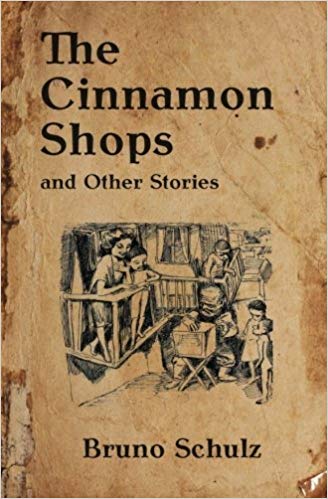In Drohobycz, a small town in Poland, then part of Austrian Galicia, now Ukraine, between 1892 and 1942, lived Bruno Schulz: a drawing teacher, the son of a Jewish textile merchant and a writer. He left behind two books of short stories, a novella, some letters, many drawings, some murals, and the rumour of a novel, titled The Messiah, which may never return to the world.
In 1934, at the age of forty, and with the help of the writer Zofia Nałkowska, his first book Sklepy cynamonowe (Cinnamon Shops) was published, later translated by Celina Wieniewska, together with the novella The Comet. Schulz’s writing has been described as grotesque, surreal, baroque, expressionistic, symbolist and modernist, as visionary, mystical and, far better, in the words of his biographer Jerzy Ficowski, ‘the source of intense delight and revelation’.

Cinnamon Shops is an entire world, within and beyond our own. In Schulz’s essay ‘The Mythologization of Reality’ (translated by John M. Bates) he wrote:
‘The life of the word resides in the fact that it tenses and strains to produce a thousand associations, like the quartered body of the snake of legend, whose separate pieces sought each other in the dark.’
Word calls to word from out of the mythic past, but Schulz’s collection is no dry, philological exercise. Immense energy, feeling and meaning are released with each reading. The stories are deeply playful, funny, desperate, kinetic, ceaselessly entertaining. They are dreamlike but not surreal, because they are precise, intensely noticed, and because out from the provincial settings of dusty streets and tailor shops we, as readers, are headed towards a profound knowledge, and, perhaps, a different sense of ourselves. In Schulz’s words, again: ‘The driving force of human knowledge is the conviction that at the end of its investigations, it will discover the ultimate meaning of the world.’
The stories in Cinnamon Shops often look out onto the world with the eyes of childhood – ‘the age of genius’, as Schulz put it – but without sentimentality, and without his vision clouding over with loss or pain.
Time, in the stories, is spatialised, and as labyrinthine as a book. Shops are stories, ‘nests of brightness’, filled with goods and bustling with people. Sensory descriptions are doors or windows, or, again, books, that open out synesthetically onto more stories, onto myths, onto senses. This, for example, from the story ‘August’:
‘Dizzy with light, we dipped into that enormous book of holidays, its pages blazing with sunshine and scented with the sweet melting pulp of golden pears.’
In ‘The Street of Crocodiles’ Schulz divines life in every non-living thing, from words to eggs, from shops to cinnamon, and in this way becomes a source not only of meaning but of feeling and of life itself, as close to inexhaustible as a book of stories can get.
*
I will not write much of Schulz’s death or name his killer. Schulz’s work deserves to live alone, above and beyond his end (his murderer is undeserving even of his portion of infamy in the history of death).
This is how Bruno Schulz did not die. Alone before an unknown ocean, heaving and rustling, made of withered pages of countless number, marked with the ink of a million, million hands, Schulz fixed his tie and smoothed back his hair and, with a curling manuscript bulking under his arm, and as the tide rose to his shiny shoes, he left the shore forever.
*
There is a new translation of the Collected Stories of Bruno Schulz, translated by Madeline G. Levine, and with an excellent introduction by Rivka Galchen, published by Northwestern University Press. From my little reading so far, this will live very happily together with the earlier translation, despite attempts by some reviewers to set them in contention with one another.







